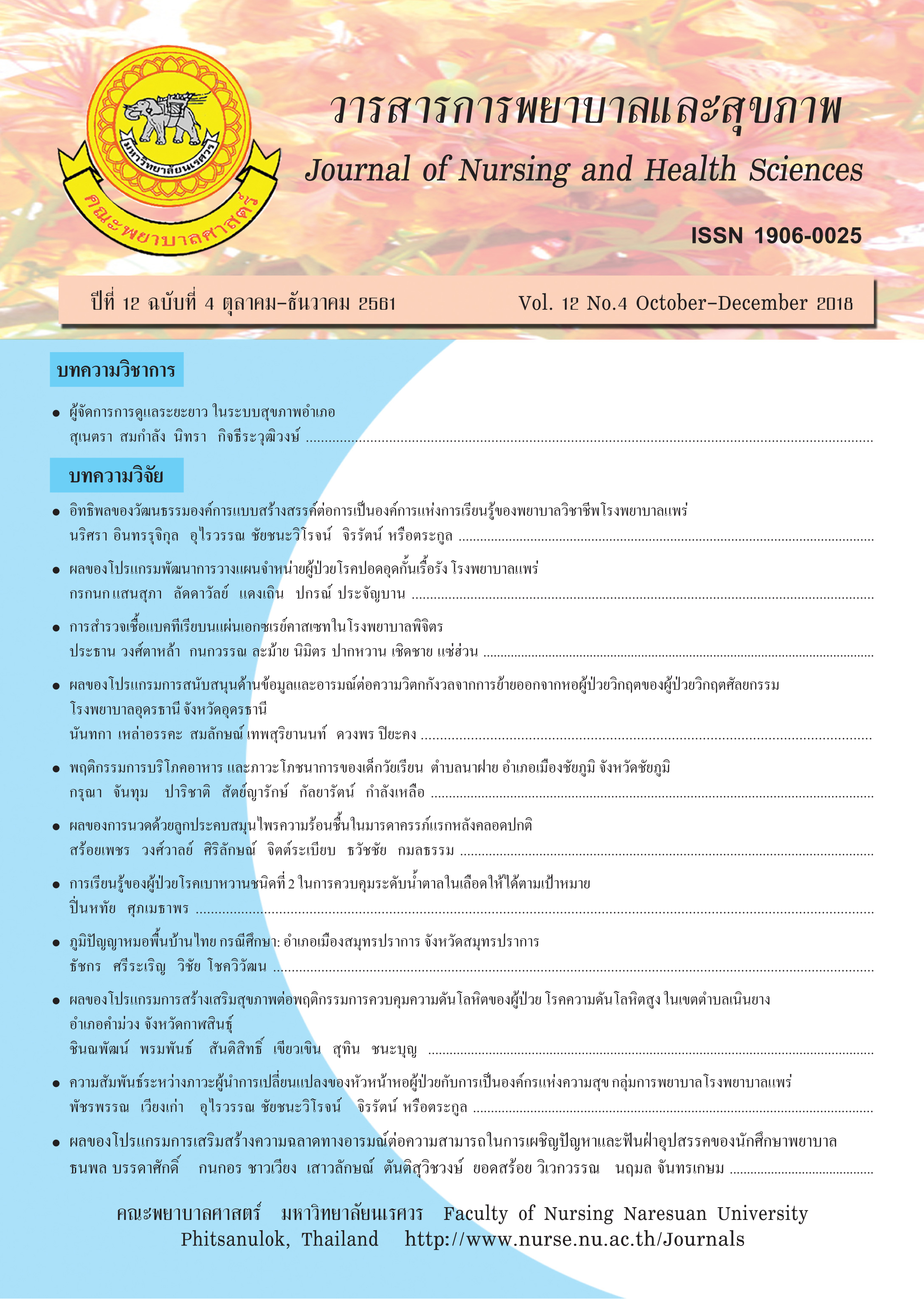Food Consumption Behaviors and Nutritional Status of School Age Children in Na Fai Sub-District, Mueang District, Chaiyaphum Province
Main Article Content
Abstract
The objective of this descriptive study was to study nutritional habits and nutritional status of school children. The study population was school children in Na Fai Sub-District, Mueang District, Chaiyaphum Province, in seven schools. The samples were 357 childrens. Instrument were food consumption behavior questionnaire and nutritional assessment of school children developed by Department of Health, Ministry of Public Health. Content validity was reviewed by the experts and the reliability was 0.79. The data were analyzed using descriptive statistics. The result show that The sample had dietary habits. Main meals were 3 meals a day, breakfast, lunch and dinner 88.2%, 96.9% and 96.1%. The types of food that were eaten during the three main meals (breakfast, lunch and dinner) were 81.6%, 68.5% and 90.7%. Snacks (breakfast, lunch and dinner) were 49.5%, 74.0% and 60.6%. Fruit (breakfast, lunch and dinner) accounted for 45.4%, 53.2% and 50.4%. Drinks were served (breakfast, lunch and dinner) 58.1%, 59.2% and 56.9%. Nutrition status is divided into 3 aspects: Weight for Age, Height for Age and Weight for Height. The results of the study as follows: 1.Weight for Age, 73.0% of males and 53.6% of females wereunderweight. 2.Height for Age, 52.4% of males and 50.6% of females were stunting. 3.Weight for Height, 61.4% of males and 58.3% of females were Wasting.
Article Details
References
การใช้เกณฑ์อ้างอิง น้ำหนัก ส่วนสูงเพื่อ
ประเมินการเจริญเติบโตของเด็กไทย. สืบค้น
เมื่อ 21 สิงหาคม 2561 จาก http://nutrition.
anamai. moph.go.th/weight.pdf
กองแผนงาน กรมอนามัย กระทรวงสาธารณสุข. (2561).
คู่มือการตรวจราชการกระทรวงสาธารณสุข
และนิเทศงานกรมอนามัย ประจำปีงบประมาณ
2561, สืบค้นเมื่อ 1 ตุลาคม 2561 จาก http://
nutrition.anamai.moph.go.th/ewt_news.
php?nid=385
นพร อึ้งอาภรณ์. (2556). ความชุกและปัจจัยที่มีความ
สัมพันธ์กับภาวะโภชนาการของเด็กวัยก่อนเรียน
ในพื้นที่ตำบลรอบมหาวิทยาลัยเทคโนโลยี
สุรนารี. วารสารกุมารเวชศาสตร์, 52(1), 70-82.
นครินทร์ บุญมี และเกียรติรัตน์ คุณารัตนพฤกษ์. (2556).
ความมั่นคงทางด้านอาหารของเด็กวัยก่อนเรียน
และครัวเรือนของ เด็กวัยก่อนเรียน ในเขตพื้นที่
การปกครองแบบพิเศษ (โคกนาคอง) อำเภอเมือง
จังหวัดอุดรธานี. KKU Res J (GS), 13(4), 111-
121.
ประสิทธิ์ เขจรจิตร, นิภาพร ชุติมันต์ และบังอร
กุมพล. (2556). ปัจจัยที่มีความสัมพันธ์ต่อภาวะ
โภชนาการต่ำของเด็กวัยก่อนเรียนใน อำเภอ
กุฉินารายณ์ จังหวัดกาฬสินธ์ุ. วารสารวิจัย
สาธารณสุขศาสตร์ มหาวิทยาลัยขอนแก่น,
6(3), 168-175.
พานทอง ภูชัย และคำเส็ง พิลาวง. (2557). ภาวะโภช
นาการและปัจจัยที่มีความสัมพันธ์กับภาวะ
โภชนาการของเด็กอายุ 2-5 ปี เมืองสีสัตะนาก
นครหลวงเวียงจันทร์ สาธารณรัฐประชาธิปไตย
ประชาชนลาว. วารสารวิจัยสาธารณสุขศาสตร์
มหาวิทยาลัยขอนแก่น, 7(1), 58-65.
เพ็ญแข ประทุมชาติ. (2549). การส่งเสริมโภชนาการ
ในนักเรียนวัยรุ่นโดยการมีส่วนร่วมของครู
และนักเรียนในโรงเรียนพังทุยพัฒนศึกษา
อำเภอน้ำพอง จังหวัดขอนแก่น. วิทยานิพนธ์
ส.ม., มหาวิทยาลัยขอนแก่น, ขอนแก่น.
รุ่งนภา สูตินันท์โอภาส และภาณุพงษ์กิตติศรีวรพันธ์.
(2559). ภาวะโภชนาการกับพฤติกรรมการ
บริโภคอาหารของนักเรียนระดับประถมศึกษา
โรงเรียนสังกัดเทศบาลเมืองลำปาง. ใน โครงการ
การประชุมวิชาการเสนอผลงานวิจัย มหาวิทยาลัย
พายัพ พ.ศ. 2559 (Payap University Research
Symposium 2016)(หน้า 1009-1016). เชียงใหม่:
สำนักวิจัยและบริการวิชาการ มหาวิทยาลัย
พายัพ.
ลัดดา เหมาะสุวรรณ. (2552). รายงานการสำรวจสุขภาพ
ประชาชนไทยโดยการตรวจร่างกายครั้งที่ 4
พ.ศ.2551-2552 : สุขภาพเด็ก. นนทบุรี: ม.ป.พ.
วิภาวี รอดทรัพย์ และสุวลี โล่วิรกรณ์. (2558). พฤติกรรม
การบริโภคอาหารและภาวะโภชนาการของเด็ก
สมาธิสั้นในโรงพยาบาลจิตเวช นครราชสีมาราช
นครินทร์. วารสารศูนย์การศึกษาแพทยศาสตร์
คลินิก โรงพยาบาลพระปกเกล้า, 32(3), 204-217.
ศันสนีย์ เมฆรุ่งเรืองวงศ์, นิทรา กิจธีระวุฒิวงษ์ และชวลิต
วโรดมรังสิมันต์. (2558). ปัจจัยที่มีความสัมพันธ์
กับพฤติกรรมการบริโภคอาหารของนักเรียน
มัธยมศึกษาในจังหวัดพิษณุโลกที่มีภาวะ
โภชนาการแตกต่างกัน. วารสารการพยาบาลและ
การดูแลสุขภาพ, 3(33), 80-90.
อดิษา สังขะทิพย์ และสุวลี โล่วิรกรณ์. (2560). พฤติกรรม
การบริโภคอาหารและภาวะโภชนาการของ
นักเรียนชั้นมัธยมศึกษาตอนต้น โรงเรียนใน
ตำบลกุดปลาดุก อำเภอชื่นชม จังหวัดมหาสารคาม.
วารสารวิทยาศาสตร์และเทคโนโลยี มหาวิทยาลัย
อุบลราชธานี, 19(1), 178-189.
Akinbami, L., Kit, B., & Carroll, M. (2017). Trends in
anthropometric measures among US children
6 to 23 months, 1976–2014. Pediatrics, 139(3),
e20163374.
Aguayo, V., Badgaiyan, N., &Dzed, L. (2017).
Determinants of child wasting in Bhutan.
Insights from nationally representative data.
Public Health Nutr, 20(2), 1–10.
Black, R., Victory, C.,& Walker, S. (2013). Maternal
and child undernutrition and overweight in
low-income and middle-income countries.
Lancet, 382(9890), 427–51.
Hedley, A.A., Ogden, C.L., Carroll, M.D., &Flegal,
K.M. (2004). Prevalence of overweight and
obesity among US children, adolescents, and
adults, 1999-2002. JAMA, 291, 2847-50.
Mo-Suwan, L. (2009). Nutritional Status in Children.
In Thai Health Survey Network Thai Health
Survey Report By the 4th Physical Examination
2008- 2009 (Children’s Health),(Page 103-
123).Retrieved 7 August 2018 from http://
www.hiso.or.th/hiso5/report/ report5.php.
(in Thai).
Onis, M., &Branca, F. (2016). Childhood stunting: a
global perspective. Mater Child Nutr, 12(S1),
12-26.
Paul, C.M., Mythili, G., & Paul, V.V. (2017). A crosssectional
study on the prevalence of acute and
chronic malnutrition among children in the
under-five children in a Chennai based
population. Glob J For Res Anal, 5(11), 76-78.
Paul, S.L., & Stanley, L. (2009). Sampling of
population: method and applications(4thed).
New York: John Wiley&Sons.
Psaki, S., Bhutta, Z. A., Ahmed, T., Ahmed, S., Bessong,
P., Islam, M. (2012). Household Food Access
and Child Malnutrition: Results from the
Eight-Country MAL-ED Study. Population
Health Metrics, 10(1), 24.
Sharghi, A., Kamran, A., &Faridan, M. (2011).
Evaluating Risk for Protein-Energy Malnutrition
in Under the Age of Six Years: a Case-Control
Study from Iran. International Journal of
General Medicine, 4, 607-611.
Suri, S., & Kumar, D. (2015). Nutritional Status and the
Factors Associated with it among Children
Aged 1-5 Years in a Rural Area of Jammu.
International Journal of Sciencetific Study, 3(3),
60-64.
Unicef.(2013). Improving child nutrition: the achievable
imperative for global progress. ISBN: 978-92-
806-4686-3.
World Health Organizationd. (2012). Nutrition
landscape information system (NLIS)
country profile indicators: interpretation guide.
World Health Organizationd. (2016). Nutrition
Disorders. Retrieved 21 August 2016 from
http://www.who.int/topics/nutrition_disorders/
en/.


